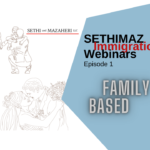Introduction
Have you gotten your green card application approved? If yes, GREAT! You have taken another step in becoming a US citizen. Becoming a US citizen is a dream of a lot of noncitizens. So knowing the process and timeline is always beneficial for a green card holder.
US citizenship grants new rights and privileges to the persons who get naturalized, such as the right to vote in federal elections, get a US passport, or permanent protection from deportation. The naturalization process demands a wait of 3-5 years after getting your green card. Ensure to be aware of when you become eligible for naturalization and apply for it as soon as you get eligible. This article will provide an insight on the waiting period for naturalization on an employment-based green card, marriage-based green card, and if you married a US citizen after obtaining an employment-based green card.
Naturalization after Employment-Based green card
Say you have adjusted your status from an Employment-Based – First Preference (EB-1) visa and obtained a green card. The basis of your green card is employment. The fundamental rule is that you cannot apply for naturalization until you have resided in the US for at least five years as a legal permanent residence unless you marry a US citizen and you have resided with your US citizen spouse for at least three years.
For example, the date on your green card is June 19, 2021 (the date you became legal permanent residence); you are eligible for naturalization after five years, i.e., June 19, 2026, provided that there is no deducted time in your span of stay. You should note that you can file your citizenship application (Form N-400) 90 days before your eligibility date; in this scenario, March 21, 2026. You have to maintain continuous residence in the US for at least five years after obtaining a green card through employment.
Now, suppose that the date on your green card is June 19, 2021 (the date you became legal permanent residence), and you get married to a US citizen on June 19, 2022. In this scenario, you can be eligible for naturalization after three years of marriage, meaning June 19, 2025, instead of June 19, 2026. You can file your application 90 days before the eligibility date, meaning on March 21, 2025.
US Citizenship after Marriage Green Card
Obtaining a green card on marriage provides additional perks. You do not have to wait for five years to become eligible for the naturalization process. “Three-year rule” applies to those with a US spouse and obtains a green card through marriage. One of the necessary conditions to take benefits under this rule is to live together with your marital US spouse for at least three years before filing for naturalization.

What if I get a divorce from your spouse in the three years continuous residence period?
You are lucky that even if you have obtained your green card based on your marriage, getting a divorce will not affect your chances of becoming a US citizen. However, if you get a divorce, you will lose the advantage of filing for naturalization after three years and have to wait for five years.
I obtained my Green Card through employment but got married to a US citizen right after. Can I file my citizenship application in 3 years?
It does not matter how you obtain your green card. The exception of the three-year rule will apply even if you do not get your green card based on marriage to a US citizen.
For instance — you have come to the US on an offer of employment from a US employer on an EB-1 visa and obtained a green card by adjusting your status. Right after you get married to a US citizen, you then have to wait for three years from the date of your marriage to apply for US citizenship.
What is the earliest time you can file for your Citizenship interview?
After obtaining your green card, you know that you have to wait for five years to apply for your naturalization except for marriage to a US spouse, where the waiting time reduces to 3 years. USCIS allows you to file Form N-400, Application for Naturalization, 90 days before you complete your permanent residence requirement to reside 3-5 years in the US. This is because USCIS typically takes at least 90 days to call you for an interview, even if the workload is normal. Therefore, you are safe applying within 90 days.
What is a disruption in continuous residence?
Continuous residence is when a green card holder maintains a residence in the US for the required time for the naturalization process. It is vital to know what constitutes the continuous period of 5 or 3 years and how not to disrupt such a period. Extended absence outside the US may disrupt an applicant’s continuous residence. The situations when a continuous residence may be disrupted are:
- Absence of more than six months and less than one year:
- Whenever a green card holder remains outside the US for more than six months, and less than one year, it is presumed that the holder’s continuous period was disrupted. However, an applicant may overcome the assumption of a break in the continuity of residence by submitting documentation establishing that the applicant did not interrupt their residence continuity. He can submit evidence such as he did not terminate his employment or his family members remain in the US during that period. For further detail, you can visit https://www.uscis.gov/policy-manual/volume-12-part-d-chapter-3.
- Absence of 1 year or more: A green card holder’s absence of 1 year or more automatically disrupts his continuity in residence. If you intend to stay outside of the US for more than one year, you must apply for reentry with USCIS before leaving the US. However, that will also be taken as a break in continuous residence.
- Absence of fewer than six months: A green card holder can travel outside the US for a span that is less than six months. It will be calculated as a continuous residence.
You can check the eligibility after you have disrupted your continuous presence at https://www.uscis.gov/policy-manual/volume-12-part-d-chapter-3.
Physical presence in the US
Physical presence refers to an applicant’s actual presence in the United States for a defined length of time. All the applicants must show physical presence for at least 30 months within the five years or 18 months if the 3-year rule applies to them.
In addition, the applicant must demonstrate that they have lived in the USCIS district or state where they claim residence for at least three months immediately prior to submitting Form N-400.
Conclusion
So are you excited to apply for the naturalization process? I guess, YES! Make sure you have completed your waiting time and fulfill all the conditions. If any question is troubling you, you can ask us, and our immigration attorneys will answer your questions.













 by Prozco®
by Prozco®